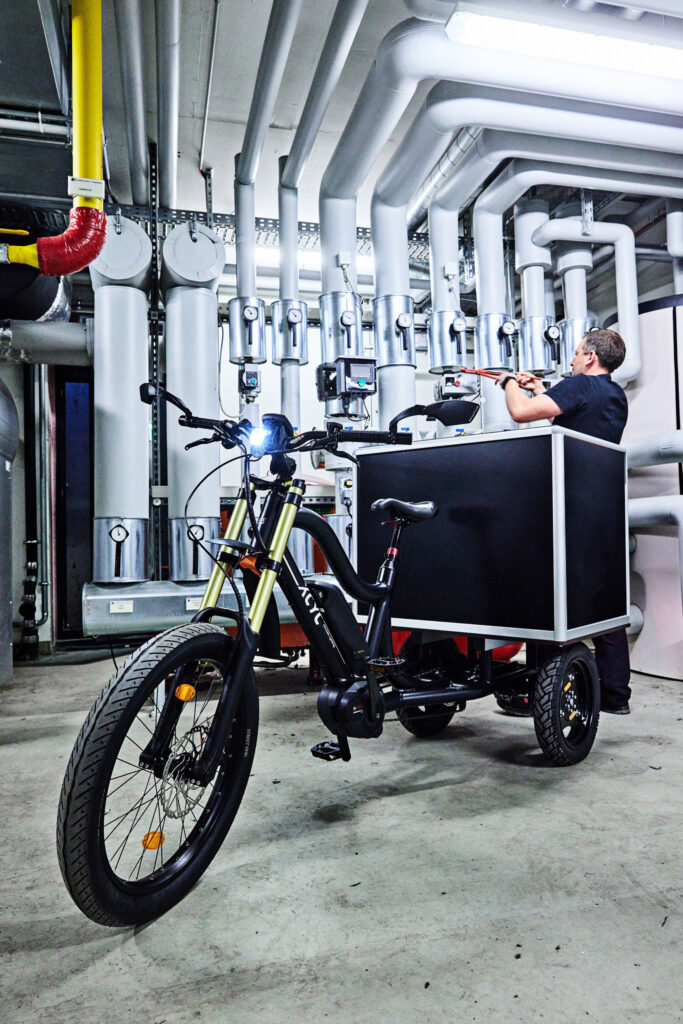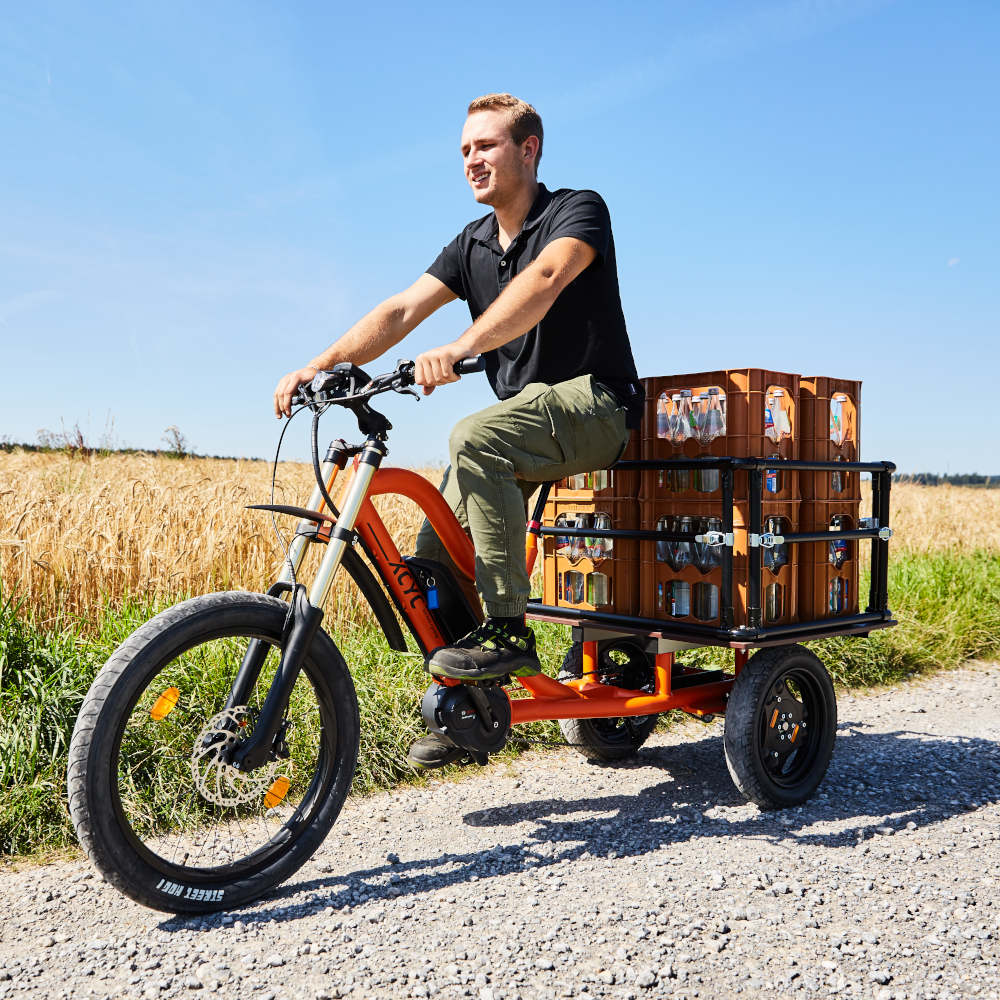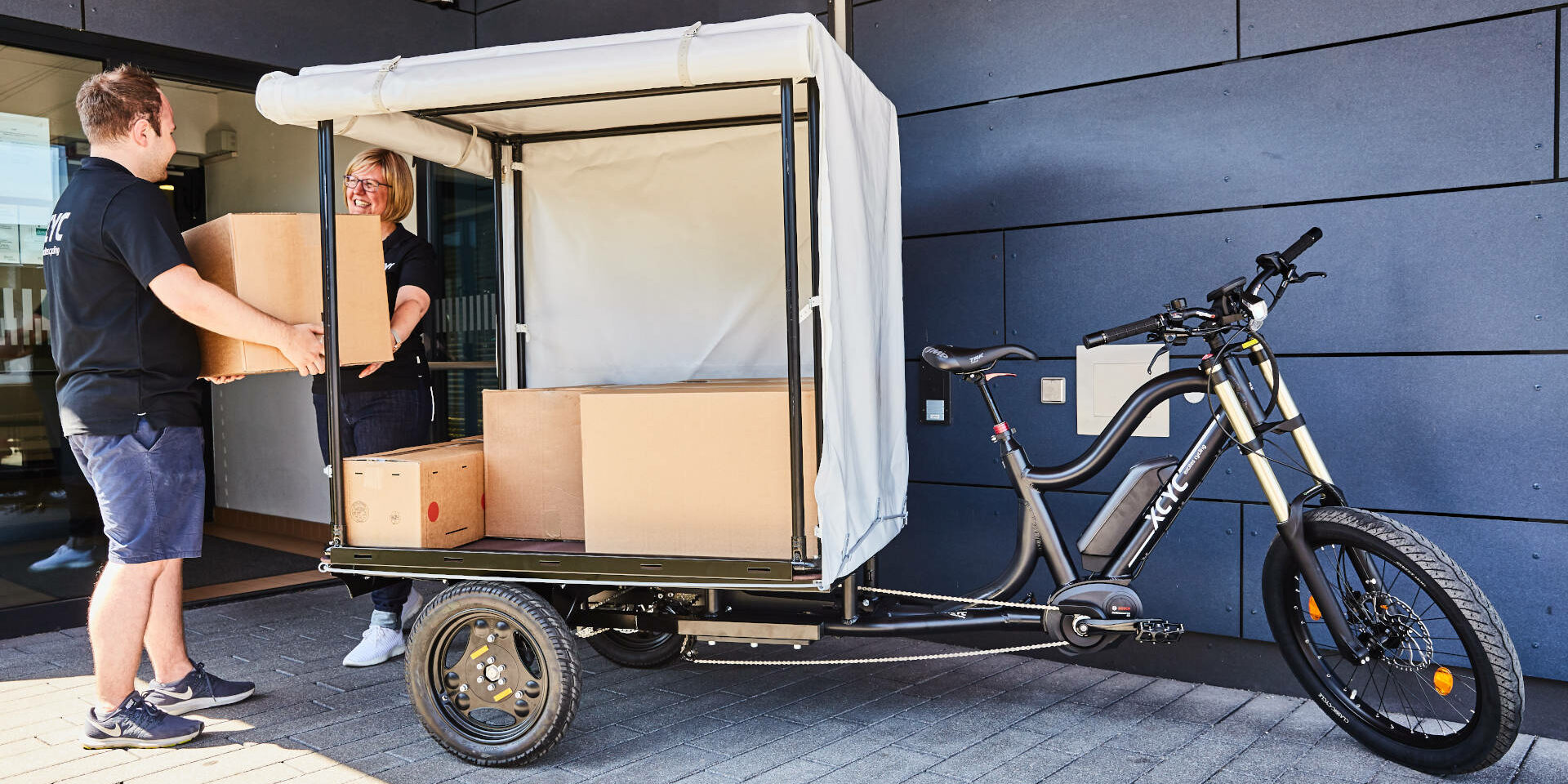- Home
- E-bike knowledge
- E-bike with trailer or cargo…
E-bike with trailer or cargo e-bike? How to make the right choice for your company
Table of Contents
In a changing world, it is time to rethink old habits and break new ground. Electromobility offers companies the opportunity to adapt to the changing requirements of modern business life. E-Bikes with trailers or cargo e-bikesare therefore already being used in companies today. But which is the better choice for your needs?
Choosing the right means of transportation for your company
Many companies have now set their sights on electromobility as one of thellogistics trends and are looking for solutions to integrate it into their logistics and transportation operations.
In addition to electric vehicles (for which a driver’s license is required), cargo e-bikes and e-bikes with trailers are also eligible. These can be driven without a driver’s license. We look at these two alternatives and compare the options.
Cargo e-bikes
Cargo e-bikes are designed for transporting loads. This involves the design, the center of gravity, the motor and battery power, the braking system and the lighting unit, among other things. You don’t have to worry much about the authorization either. All of them are designed by the manufacturers to comply with legal requirements.
E-bikes with trailer
For an e-bike to be suitable for transportation and an additional trailer, it should meet certain requirements.
Battery and motor: The motor power and battery capacity should be large enough to pull a trailer. Especially with heavy loads, the range of the e-bike is reduced and the motor could reach its limits on steep inclines.
Brakes: Safety comes first when driving, which is why it is crucial to take a look at the braking system. Note that an e-bike with a trailer has a longer braking distance.
Weight: Together, the e-bike and trailer should weigh as little as possible. This gives you a higher payload.
Authorization in Germany: Please note that trailers may not be attached to S-pedelecs. The trailer approval only applies to e-bikes with a speed of 25 km/h. Therefore, check carefully whether your e-bike is approved for a trailer and which trailers are actually suitable. Otherwise you could be fined and you will not receive any support in the event of an insurance claim.
Authorization in Switzerland:Trailers on S-Pedelecs (up to 45 km/h) are permitted in Switzerland. However, some restrictions apply:
- The trailer must be approved for use with an S-Pedelec. This can be recognized by a special sticker on the trailer.
- The total speed of the combination (S-pedelec + trailer) must not exceed 45 km/h.


E-bike with trailer or cargo e-bike?
Which is the better choice? An ordinary e-bike that is extended with a trailer, or an e-cargo bike that is already designed for transporting loads? We compare the various factors for you.
Loading capacity
The load capacity determines whether a vehicle is suitable for your company’s transportation needs. It is best to compare the payload of models, i.e. the permissible total weight minus the weight of the e-bike or cargo e-bike.
You will find that most e-bike models have a much lower permissible total weight, which is around 120 kg. If the rider then weighs 80 kg, the e-bike 10 kg and the trailer 20 kg, there is hardly any weight left for the load.
Cargo e-bikes such as the XCYCs have a higher permissible total weight of 250 to 300 kg (200 kg in Switzerland). Although a cargo e-bike weighs more than an ordinary e-bike, the weight of the additional trailer is eliminated (unless you use special attachments). This results in a payload of 100 to 200 kg.
In addition to the weight, the load volume is also important. Just as relevant is how the load is transported. If you are delivering food, for example, you need a different loading space than if you are transporting heavy parcels from A to B on the factory premises.
In general, it can be said that cargo e-bikes generally have a larger load capacity than e-bikes with a conventional bike trailer for transportation. So if you are transporting heavy loads, you are better equipped with a cargo bike.
Tip: We explain how to calculate the payload and loading capacity and load your vehicle correctly in our article on correct cargo e-bike loading.
Stability
Especially if you are transporting heavy goods, your vehicle should have a high level of stability and the frame should be designed for this. Similarly, bends or uneven terrain should not make transportation a challenge.
How stable an cargo e-bike actually is also depends on the center of gravity, the structure and the distribution of the loads. It also makes a difference whether you ride a cargo bike with two or three wheels.
The version with three wheels is generally more stable and cannot simply tip over. This is a great advantage, especially at slow speeds and when parking.
This is why these cargo bikes are often preferred in the B2B sector. Two-wheeled cargo e-bikes or e-bikes with trailers, on the other hand, are more maneuverable and a good solution for smaller transports. However, they are perceived as bumpier and bulkier when driving. The driving experience is less smooth.
While a two-wheeled e-bike allows you to lean into bends and requires balance, you can ride a three-wheeled model like a car: you steer exclusively with the handlebars, which gives you more safety when transporting heavy loads.
In general, cargo ebikes often offer better stability than e-bikes with trailers due to their wider base and low center of gravity.
Maneuverability
At first glance, e-bikes seem more maneuverable and easier to ride. However, as soon as you pull a trailer behind you, the maneuverability and overall handling change. The turning radius is larger. In addition, the braking distance is longer with a trailer on the e-bike. Depending on their size, however, e-bikes with trailers remain more agile and comparatively easy to handle even on crowded cycle paths.
Although the turning radius of cargo e-bikes is generally higher, the vehicles also remain flexible and you can also manage well in narrow lanes. The turning circle of the XCYC cargo e-bikes is 340 cm for the XCYC Allround and 460 cm for the XCYC Work, for example.
Costs
Of course, price also plays a role when choosing new transport vehicles. Here you should compare the purchase costs and operating costs, including maintenance, repairs and insurance costs.
The price range for e-bikes and cargo e-bikes is high and the costs can vary greatly depending on the brand and model. However, e-bikes are generally somewhat cheaper than cargo e-bikes. But don’t forget to factor in the cost of the trailer.
The maintenance and repair requirements depend on the model and manufacturer.
Safety
You are safe on the road with both options as long as you comply with the rules and regulations. Nevertheless, the cargo e-bikes perform a little better in comparison.
Robust frames are a basic requirement for safety when riding. In addition, optional safety features such as high performance brakes, parking brakes and integrated lighting systems can further improve safety. Not only are you safe on the road, but you can also park the cargo bike safely, even if you stop on a slope.
Cargo e-bikes - comparison of the different types
Cargo e-bikes cannot really be grouped together as they are very different in terms of structure and load distribution. This is noticeable, for example, in the riding behavior and is relevant if you choose an cargo e-bike specifically for use in your company.
Front-loading cargo e-bikes
Cargo e-bikes with a front load are generally lighter than those with a rear load. The load is located between the handlebars and the front wheel or, on some models, above the front wheel. So you always have the load in view.
However, as these models are usually two-wheeled, they are less stable and more difficult to turn. There are also models with two wheels at the front and one at the rear.
Front loaders are particularly suitable for lighter transportation and if you want to opt for a two-wheel version.
|
Advantages |
Disadvantages |
|
Lighter own weight |
Little stability |
|
Cargo in view while driving |
Harder to turn |
|
Two- and three-wheeled models |
Field of vision may be impaired |
|
Limited loading height |
Rear loading cargo e-bikes
Cargo e-bikes with rear loading (also known as trikes or long bikes) are heavier and take some getting used to, but they have many advantages.
Rear loaders are a particularly good choice for companies that focus on a large loading area. They offer stability, do not tip over and are ideal for heavy transport. As the load is at the rear, visibility is not restricted when driving. This also provides flexibility in terms of loading height.
|
Advantages |
Disadvantages |
|
High stability |
Higher net weight |
|
Easy to turn / control |
Driving behavior takes some getting used to |
|
Large loading area, not limited in height |
|
|
Suitable for heavy-duty transportation |
|
|
Unrestricted view |
|
|
Two-wheeled and three-wheeled models |
Get an impression of these cargo e-bikes here.
XCYC cargo e-bikes impress with their many advantages
Stability, load capacity, safety and good control are all points in favor of an e-cargo bike when transporting heavy loads. These vehicles have the potential to replace small vans or supplement the fleet in urban areas on the way to the last mile or on company premises.
With the XCYC cargo e-bikes, you are not only safe, but also very flexible on the road. The various superstructure systems are modular and can be fitted as required. This means you have the best conditions for every transport project and can get your load safely to its destination.
Conclusion: The time is ripe for a new era of transportation - with cargo e-bikes at the forefront
Cargo e-bikes are often in no way inferior to other means of transportation and are a wonderful alternative to cost-intensive vehicles in a company’s fleet.
Because any employee can drive them without a driver’s license and the load capacity is sufficient for most transport projects, they are a welcome addition to companies.
The high degree of flexibility makes them attractive for numerous companies: from farms and delivery services to use on factory premises.
Whether you opt for an e-bike with trailer or a cargo e-bike is of course up to you. If you have any questions on the subject or would like to test ride one of our XCYC Cargo e-bikes, just get in touch with us.






